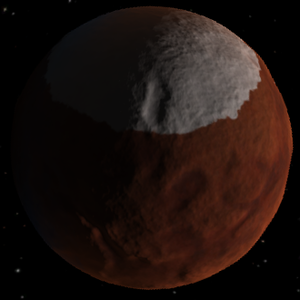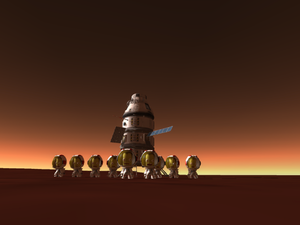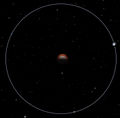Difference between revisions of "Duna"
(This is a wiki, you are not allowed to write jokes on this site.) |
(Added Game's Description) |
||
| Line 124: | Line 124: | ||
== Reference Frames == | == Reference Frames == | ||
{{:Duna/RefFrame}} | {{:Duna/RefFrame}} | ||
| + | |||
| + | == Description == | ||
| + | |||
| + | {{Quote | ||
| + | |||
| + | |Also known as the red dot that you can see if you squint at it really hard, Duna has long been a wonder to Kerbalkind. The planet has been held in much awe due to its striking red color and stark contrast to the color green. | ||
| + | |||
| + | |Kerbal Astronomical Society.}} | ||
== Gallery == | == Gallery == | ||
Revision as of 15:37, 28 March 2014
| Duna | ||
| Duna as seen from orbit. | ||
| Planet of Kerbol | ||
| Orbital Characteristics | ||
| Semi-major axis | 20 726 155 264 m [Note 1] | |
| Apoapsis | 21 783 189 163 m [Note 1] | |
| Periapsis | 19 669 121 365 m [Note 1] | |
| Orbital eccentricity | 0.051 | |
| Orbital inclination | 0.06 ° | |
| Argument of periapsis | 0 ° | |
| Longitude of the ascending node | 135.5 ° | |
| Mean anomaly | 3.14 rad (at 0s UT) | |
| Sidereal orbital period | 17 315 400 s | |
| 801 d 3 h 50 m 0.1 s | ||
| Synodic orbital period | 19 645 697.3 s | |
| Orbital velocity | 7 147 - 7 915 m/s | |
| Physical Characteristics | ||
| Equatorial radius | 320 000 m | |
| Equatorial circumference | 2 010 619 m | |
| Surface area | 1.2867964×1012 m2 | |
| Mass | 4.5154270×1021 kg | |
| Standard gravitational parameter | 3.0136321×1011 m3/s2 | |
| Density | 32 897.302 kg/m3 | |
| Surface gravity | 2.94 m/s2 (0.3 g) | |
| Escape velocity | 1 372.41 m/s | |
| Sidereal rotation period | 65 517.859 s | |
| 3 d 0 h 11 m 57.9 s | ||
| Solar day | 65 766.707 s | |
| 3 d 0 h 16 m 6.7 s | ||
| Sidereal rotational velocity | 30.688 m/s | |
| Synchronous orbit | 2 880.00 km | |
| Sphere of influence | 47 921 949 m [Note 1] | |
| Atmospheric Characteristics | ||
| Atmosphere present | Yes | |
| Atmospheric pressure | 6.75500 kPa | |
| 0.066667 atm | ||
| Atmospheric height | 50 000 m | |
| 6.7×10-8 atm | ||
| Temperaturemin | -123.15 °C 150 K | |
| Temperaturemax | -40.15 °C 233 K | |
| Oxygen present | No | |
| Scientific multiplier | ||
| Surface | 8 | |
| Splashed | N/A | |
| Lower atmosphere | 5 | |
| Upper atmosphere | 5 | |
| Near space | 7 | |
| Outer space | 5 | |
| Recovery | 5 | |
|
| ||
Duna is the fourth planet of the Kerbol star system and Mars analog for Kerbal Space Program. It is mostly red with polar icecaps and has one natural satellite, the moon Ike. Ike's size and proximity tidally locks it and Duna to each other.
With proper aerobraking, a round trip from Kerbin to Duna's orbit and back requires roughly 1700 m/s of delta-v, less than a round trip to any other planet. Duna is often the easiest planet to encounter because its orbital inclination is low.
Contents
Topography
Duna's terrain ranges in altitude from 124 to 8264 meters. Its mountainous ranges are a peril to landing craft, especially considering the thin atmosphere, which permits very little safe aerobraking and causes Duna's expansive, icy poles.
Duna has several craters, but they appear quite eroded, presumably from wind.
Several maria (large regions of dark soil) are at exactly 0 meters altitude (deprecated). Their flatness and low altitude allow for more aerobraking and make them easy but boring landing locations. These may have been lakes when the planet may have had liquid on its surface in the past.
Duna's surface contains anomolous features.
Atmosphere
Duna's atmosphere begins at 41,446 m. It is only 20% as dense as Kerbin's at sea level altitude and is even less dense relative to Kerbin at higher altitudes. At Duna's highest peak, atmospheric density is only 21% of that at sea level. For comparison, on Kerbin, the atmosphere at the highest peaks is 45% as thick as at sea level. This low density will cause parachutes to semi-deploy much lower, just over 10km for the Mk25 Parachute, and just under 9km for all the other parachutes.
In comparison is the atmosphere the thinnest of all bodies with an atmosphere. Even Jool's moon Laythe has a more dense and higher atmosphere. The atmosphere appears to have a reddish or brownish tone itself. On the poles the illuminated atmosphere is coloured although the surface is white.
Landing
Aerobraking can save fuel by reducing orbital and surface velocity greatly. An aerobraking maneuver should maximize time spent in the atmosphere by entering at a shallow angle and aiming for a landing location in a low-lying area. One estimate for a good aerobraking height is 13,000 meters, which will then allow a relatively low delta-V burn at the apoapsis to create a stable orbit safely within Ike's reign of chaos.
Like all atmospheres in the game, Duna's atmosphere fades exponentially with increasing altitude (with a scale height of 3000 m). In general, the atmospheric pressure on Duna at an altitude expressed in meters is:[1]
Although parachutes will deploy on Duna, the atmosphere is so thin that they are usually unable to slow a craft to a safe landing velocity and must be assisted with engines.
Flying
Below 5 km Duna's atmosphere is thick enough to allow wings to generate enough lift for aerodynamic flight. Jet engines don't work for want of oxygen, but other propulsion methods work well. Performing a horizontal landing with a plane is also possible.
Lifting off
An ascent to Low Duna Orbit from the surface typically requires around 1500 to 2000 m/s in Delta-V to reach a 42km altitude traveling at roughly 950 m/s.
The following table gives terminal velocities at different Duna altitudes, which also the velocities at which a ship should travel for a fuel-optimal ascent from Duna, given the game's model of atmospheric drag.[2]
| Altitude (m) | Velocity (m/s) |
|---|---|
| 0 | 212 |
| 1000 | 231 |
| 2000 | 252 |
| 3000 | 274 |
| 5000 | 324 |
| 8000 | 418 |
| 10000 | 495 |
| 13000 | 638 |
| 15000 | 756 |
| 20000 | 1.16×103 |
Tracking Station Info
Also known as the red dot that you can see if you squint really hard, Duna has long been a wonder to Kerbalkind. The planet has been held in much awe, due to its striking red color and stark contrast to the color green.
Orbital Statistics
The synchronous orbit of Duna is at an altitude of 2 880.00 km above Duna. The speed of the satellite is 306.88 m/s and it has an orbital period resonating with 1 Duna day (18.2 hours or 65517.859375 seconds). However, this is the same altitude at which Ike orbits, so unless a ship's orbit is perfectly precise, it will eventually be captured by Ike.
For a semi-synchronous orbit of ½ Duna day (9.1 hours or 32758.9295 seconds) an orbit of 1 695.87 km above Duna is needed with a velocity of 386.65 m/s.
Observation of Ike
Ike's orbit keeps it directly above a short range of Dunar longitudes. The average Duna longitude that Ike tends to stay directly above (at the Zenith) is 6 degrees east, but the eccentricity of Ike's orbit causes the exact longitude to oscillate between about 2 degrees and 10 degrees east and makes Ike appear to grow slightly larger and smaller to an observer on the surface of Duna. The latitude at which Ike is in the Zenith also oscillates between 0.2 degrees south and 0.2 degrees north due to Ike's orbital inclination, making Ike appear to rotate upwards and downwards as viewed from the surface, but due to the extremely small orbital inclination, this effect is nearly imperceptible. These phenomena together are known as libration. The oscillation in Ike's position above the horizon allows areas from 88°W to 80°W and 92°E to 100°E on Duna to observe Ike rise and set at least partially across the horizon, as can any areas north of 89.8°N or south of 89.8°S.
Interplanetary Travel
From altitude orbit around Duna, the delta-V needed to reach the orbits of other celestials is:
| Body | Delta-V | |
|---|---|---|
| Ike | ~300 m/s | |
| Kerbin | ~620 m/s | |
| Dres | ~820 m/s | |
| Eve | ~1080 m/s | |
| Jool | ~1350 m/s | |
| Eeloo | ~1580 m/s | |
| Moho | ~2100 m/s | |
Reference Frames
| Time warp | Minimum Altitude |
|---|---|
| 1× | Any |
| 5× | 50 000 m (above the atmosphere) |
| 10× | 50 000 m (above the atmosphere) |
| 50× | 60 000 m |
| 100× | 100 000 m |
| 1 000× | 300 000 m |
| 10 000× | 600 000 m |
| 100 000× | 800 000 m |
Description
| “ | Also known as the red dot that you can see if you squint at it really hard, Duna has long been a wonder to Kerbalkind. The planet has been held in much awe due to its striking red color and stark contrast to the color green. — Kerbal Astronomical Society. |
” |
Gallery
Duna at sunrise
Changes
- Art Pass
- Minor art pass
- Initial Release
Trivia
- Duna's name may be either a reference to its desert landscape or a shout-out to the Frank Herbert novel Dune.
- The low-lying areas near Duna's equator make a shape resembling Europe.
- On the surface of Duna, there is a large monument carved in the likeness of a Kerbal face, alluding to the infamous "Face of Mars" discovered in the Cydonia Mensae region of Mars during the 1970's.
- Buried deep under the surface, there is a small camera, similar to the design on the Curiosity rover.
- One anomalous feature on Duna is a small, pyramid-like hill emitting an SSTV signal. When decrypted, it shows a diagram-like image of three figures standing next to the hill itself, implying that Duna was once inhabited or visited before.
Notes
- ↑ A LV-N Atomic Rocket Motor has a specific impulse of 220 in 1 atm, 800 in vacuum, and the following at various Duna altitudes:
altitude (m) 2 100 300 500 1460 2420 3000 4272 5000 10000 specific impulse 684.1 687.8 695.1 701.8 728.7 748.2 757.3 772.1 778.1 795.9 - ↑ http://forum.kerbalspaceprogram.com/showthread.php/6664-Mini-challenge-max-altitude-with-this-supplied-spacecraft?p=100912&viewfull=1#post100912



















